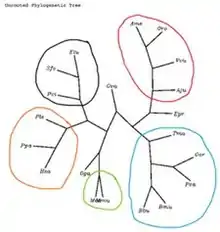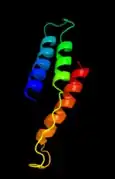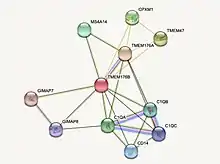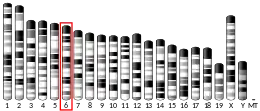Transmembrane Protein 176B, or TMEM176B is a transmembrane protein that in humans is encoded by the TMEM176B gene. It is thought to play a role in the process of maturation of dendritic cells.[5]
Gene
Location
TMEM176B is also known as LR8, and MS4B2.[6] The gene is found on the minus end of Chromosome 7, on the long arm at position 7q36.1.[7] The starting position of the gene is at 150,791,287 and goes to 150,801,360. It has 10,074 base pairs and has a total of 11 exons.[8]
Gene
Expression
The gene is found to be most expressed in the liver with the kidney being the second most expressed tissue.[6]
Transcript variants
There are 3 isoforms (A, B, C) of this gene with variants of isoform A and C. Isoform A variant 1 has 1444 nucleotides that encode 270 amino acids. There are 17 alternatively spliced variants with 1 unspliced transcript variant.[11]
Homology
Paralogs
Orthologs

Below is a table of orthologs of TMEM176B, these include close and somewhat distant orthologs.
| Common name | Accession number | Sequence length | Sequence identity | Sequence similarity |
|---|---|---|---|---|
| Human | NP_054739.3 | 270 | 100 | 100 |
| Bonobo | XP_008966185.1 | 286 | 99 | 98 |
| Ugandan red colobus | XP_023081229.1 | 268 | 91 | 92 |
| Small-eared galago | XP_003792108.1 | 268 | 68 | 77 |
| Sunda flying lemur | XP_008564209.1 | 271 | 71 | 80 |
| House mouse | NP_001273581.1 | 263 | 53 | 66 |
| Ryukyu mouse | XP_021020106.1 | 265 | 53 | 67 |
| Przewalski's horse | XP_008506799.1 | 270 | 70 | 80 |
| Cheetah | XP_026907001.1 | 271 | 68 | 77 |
| Water buffalo | XP_006049155.1 | 265 | 66 | 76 |
| Wild yak | XP_005908946.1 | 265 | 65 | 75 |
| Sperm whale | XP_028345261.1 | 266 | 65 | 73 |
| Killer whale | XP_012392713.1 | 265 | 64 | 73 |
| Pacific walrus | XP_004408899.1 | 271 | 64 | 75 |
| Giant panda | XP_019651134.1 | 271 | 68 | 79 |
| Red fox | XP_025849593.1 | 273 | 63 | 73 |
| West Indian manatee | XP_004372786.1 | 271 | 66 | 76 |
| Koala | XP_020833594.1 | 268 | 46 | 62 |
| Asian arowana | XP_018595194.1 | 252 | 38 | 47 |
| Northern pike | XP_010904195.4 | 251 | 26 | 46 |
There are around 125 orthologs of the gene ranging from primates to mice and to certain species of fish.[13]
Homologs
The homologs of this gene include chimpanzee, rhesus monkey, dog, cow, mouse, and rat.[14]
Protein

The molecular weight of TMEM176B is 29.1 kilodaltons (kDa). The protein is rich in valine and poor in aspartic acid.[15] There are 4 transmembrane regions within TMEM176B isoform a.[16] There is a CD20 domain from 198-687.[17]
Domains
The CD20-like family includes the CD20 gene but is part of the family pfam04103 which is part of superfamily cl04401. This specific domain region is 489 bp.[18]
Secondary structure
TMEM176B is composed of alpha helices, beta strands and TM helices. The Alpha helices make up most of the secondary structure followed by TM helices.[19]
Subcellular localization
Mainly localized to the Golgi apparatus but is additionally localized to the plasma membrane and nucleoplasm.[20]
Protein-protein interactions
The protein interacts most commonly with TMEM176A. It also interacts with TMEM47 and CPXM1 (carboxypeptidase 1) but at lower levels.[21]

Regulation
Gene
There are 11 promoters in TMEM176B. The promoter region before isoform a is 1101 bp and covers 150,799,077-150,800,177.[22]
Protein
There are 4 phosphorylation sites in TMEM176B isoform a.[23]
Clinical significance
There has been research that indicates that TMEM176B is associated with cancer when an abnormal of the gene accumulates.[24]
References
- 1 2 3 GRCh38: Ensembl release 89: ENSG00000106565 - Ensembl, May 2017
- 1 2 3 GRCm38: Ensembl release 89: ENSMUSG00000029810 - Ensembl, May 2017
- ↑ "Human PubMed Reference:". National Center for Biotechnology Information, U.S. National Library of Medicine.
- ↑ "Mouse PubMed Reference:". National Center for Biotechnology Information, U.S. National Library of Medicine.
- ↑ Picotto G, Morse L, Nguyen N, Saltzman J, Battaglino R (July 2019). "TMEM176A and TMEM176B are candidate regulators of inhibition of dendritic cell maturation and function after chronic spinal cord injury". Journal of Neurotrauma. 37 (3): 528–533. doi:10.1089/neu.2019.6498. PMC 6978786. PMID 31354034.
- 1 2 Universal protein resource accession number Q3YBM2 for "Transmembrane Protein 176B" at UniProt.
- ↑ "TMEM176B Transmembrane Protein 176B [Homo Sapiens (Human)] - Gene - NCBI". Ncbi.Nlm.Nih.Gov, 2019, https://www.ncbi.nlm.nih.gov/gene?cmd=Retrieve&dopt=full_report&list_uids=28959.
- ↑ "Homo Sapiens Chromosome 7, Grch38.P13 Primary Assembly - Nucleotide - NCBI". Ncbi.Nlm.Nih.Gov, 2019, https://www.ncbi.nlm.nih.gov/nuccore/NC_000007.14?report=fasta&from=150791287&to=150801360&strand=true.
- ↑ "Geneloc Integrated Map For Chromosome 7: Search Results". Genecards.Weizmann.Ac.Il, 2019, https://genecards.weizmann.ac.il/geneloc-bin/display_map.pl?chr_nr=7&range_type=gc_id&gc_id=GC07M150791#GC07M150791.
- ↑ Genecards.Org, 2019, https://www.genecards.org/cgi-bin/carddisp.pl?gene=LOC105375566.
- ↑ Danielle Thierry-Mieg and Jean Thierry-Mieg, . "Aceview: Geneid:TMEM176B, A Comprehensive Annotation Of Human, Mouse And Worm Genes With Mrnas Or Estsaceview.". Ncbi.Nlm.Nih.Gov, 2019, https://www.ncbi.nlm.nih.gov/IEB/Research/Acembly/av.cgi?c=geneid&org=9606&l=28959.
- ↑ "Gene: TMEM176A (ENSG00000002933) - Paralogues - Homo Sapiens - Ensembl Genome Browser 97". Useast.Ensembl.Org, 2019, http://useast.ensembl.org/Homo_sapiens/Gene/Compara_Paralog?g=ENSG00000002933;r=7:150800403-150805118.
- ↑ "TMEM176B Orthologs". NCBI, 2019, https://www.ncbi.nlm.nih.gov/gene/28959/ortholog/?scope=117570.
- ↑ Homologene - NCBI". Ncbi.Nlm.Nih.Gov, 2019, https://www.ncbi.nlm.nih.gov/homologene/8521.
- ↑ "SAPS Results". Ebi.Ac.Uk, 2019, https://www.ebi.ac.uk/Tools/services/web/toolresult.ebi?jobId=saps-I20190730-112615-0877-10414538-p2m.
- ↑ 2019, https://psort.hgc.jp/cgi-bin/runpsort.pl%5B%5D. Accessed 4 Aug 2019.
- ↑ "Transmembrane Protein 176B Isoform A [Homo Sapiens] - Protein - NCBI". Ncbi.Nlm.Nih.Gov, 2019, https://www.ncbi.nlm.nih.gov/protein/NP_054739.3.
- ↑ "CDD Conserved Protein Domain Family: CD20". Ncbi.Nlm.Nih.Gov, 2019, https://www.ncbi.nlm.nih.gov/Structure/cdd/cddsrv.cgi?uid=309291.
- ↑ "Phyre 2 Results For Undefined". Sbg.Bio.Ic.Ac.Uk, 2019, http://www.sbg.bio.ic.ac.uk/phyre2/phyre2_output/607daef47ac621bf/summary.html.
- ↑ "Cell Atlas - TMEM176B - The Human Protein Atlas". Proteinatlas.Org, 2019, http://www.proteinatlas.org/ENSG00000106565-TMEM176B/cell.
- ↑ "TMEM176B Protein (Human) - STRING Interaction Network". String-Db.Org, 2019, https://string-db.org/cgi/network.pl?taskId=YtRoRnnnUnu6.
- ↑ "Genomatix". Genomatix.De, 2019, https://www.genomatix.de/cgi-bin/eldorado/eldorado.pl?s=31f15c28bad5fbc98bd01817d3f6f82f;SHOW_ANNOTATION=result_1;ELDORADO_VERSION=E34R1811.
- ↑ Transmembrane Protein 176B Isoform A [Homo Sapiens] - Protein - NCBI". Ncbi.Nlm.Nih.Gov, 2019, https://www.ncbi.nlm.nih.gov/protein/NP_054739.3.
- ↑ Cuajungco MP, Podevin W, Valluri VK, Bui Q, Nguyen VH, Taylor K (November 2012). "Abnormal accumulation of human transmembrane (TMEM)-176A and 176B proteins is associated with cancer pathology". Acta Histochemica. 114 (7): 705–12. doi:10.1016/j.acthis.2011.12.006. PMC 5419829. PMID 22244448.




